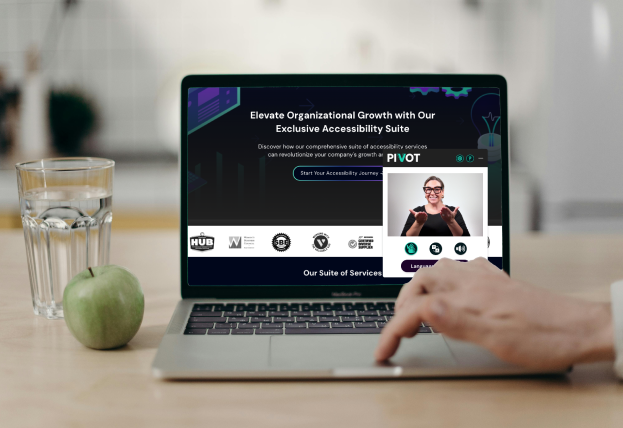In healthcare, clear communication is not just important—it’s essential. Effective communication can mean the difference between accurate diagnoses, effective treatment plans, and patient safety. Yet, for millions of individuals who are deaf or hard of hearing, traditional healthcare settings often pose significant barriers to care. Language accessibility, especially in medical settings, is a critical, yet often overlooked, aspect of equitable healthcare.
Why Language Accessibility Matters
Language accessibility in healthcare is about ensuring that everyone, regardless of their hearing ability, can fully understand and participate in their healthcare. The deaf and hard-of-hearing communities face unique challenges when it comes to accessing medical information. Without appropriate language support, patients may miss out on crucial information about their health, treatments, and medications, which can lead to miscommunication, poor health outcomes, and even dangerous situations.
For example, a patient who doesn’t fully understand the instructions for taking a prescribed medication due to the lack of interpreter services could accidentally harm themselves. This is just one instance where the absence of language accessibility can have severe consequences.
The Deaf and Hard-of-Hearing Experience in Healthcare
Studies show that people who are deaf or hard of hearing are less likely to receive adequate healthcare services compared to their hearing counterparts. A significant part of this disparity stems from a lack of effective communication in medical settings. Many healthcare providers are not equipped with the resources to provide language services, such as American Sign Language (ASL) interpreters, real-time captioning, or speech-to-text technologies. As a result, patients may find it difficult to communicate their symptoms, ask questions about their condition, or understand what healthcare providers are saying.
The Importance of Sign Language Interpreting Services
One of the most straightforward and effective solutions to this problem is offering sign language interpreters for deaf and hard-of-hearing patients. Interpreters serve as vital mediators, ensuring patients can communicate with their healthcare providers and receive accurate, personalized care.
Sign language interpreters provide more than just a translation of words—they convey meaning, tone, and nuances that are crucial for informed medical decision-making. Without an interpreter, a patient may misunderstand complex medical terms, instructions, or even the emotional support that is a key part of compassionate care.
Real-Time Captioning and Speech-to-Text Technology
While sign language interpretation is invaluable, it’s not the only solution. Captioning and speech-to-text technology are increasingly important tools for improving accessibility. These technologies can display spoken dialogue in real time, allowing deaf and hard-of-hearing individuals to read everything said during medical consultations. This empowers patients to be active participants in their care, ensuring they understand the advice and information being provided.
Additionally, these technologies can be integrated into telehealth settings, which have become increasingly common. Telehealth sessions are an especially vital service for individuals with mobility challenges or those living in remote areas, and offering real-time captioning makes these sessions accessible to deaf and hard-of-hearing patients.
The Legal and Ethical Imperative
The Americans with Disabilities Act (ADA) mandates that healthcare providers offer accessible services to patients with disabilities, including those who are deaf or hard of hearing. Failing to provide adequate language services is not only unethical but also illegal. However, compliance is just the beginning—healthcare providers have a moral duty to ensure that their patients can access information, make informed decisions, and have an equal opportunity to achieve good health outcomes.
Embracing accessibility is also a powerful tool for fostering patient trust and loyalty. When patients feel valued and understood, they are more likely to engage in their healthcare, adhere to treatment plans, and communicate openly with their providers.
The Role of accesszanü in Healthcare Accessibility
At accesszanü, we specialize in providing solutions that bridge communication gaps in medical settings. Our services include sign language interpreting, captioning, and expert accessibility consultation to ensure that healthcare providers can offer accessible services to all patients. By integrating these services, healthcare professionals can not only comply with legal requirements but also create an inclusive environment where all patients feel heard and respected.
We understand the challenges of navigating the healthcare system for deaf and hard-of-hearing individuals, and we’re committed to providing the tools and expertise to make healthcare settings more accessible. Whether it’s through in-person interpreting services or cutting-edge technologies like PIVOT, we help medical facilities ensure that every patient has equal access to care.
The Path Forward
Language accessibility in healthcare is not a luxury; it is a necessity. It’s crucial that accessibility is integrated into every aspect of patient care. From routine appointments to emergency procedures, every patient deserves to have their voice heard and their needs understood.
Healthcare providers who prioritize language accessibility are not only helping their patients—they’re building a more inclusive and equitable healthcare system for all. By adopting services like sign language interpreting and captioning, providers can ensure that no patient is left behind. By partnering with organizations like accesszanü, they can take the first steps toward creating a truly accessible healthcare experience.
The critical need for language accessibility in medical settings cannot be overstated. Healthcare is a fundamental human right, and effective communication is essential to delivering quality care. By investing in accessibility solutions, healthcare providers can create environments where all patients—regardless of their hearing ability—have equal access to the information and care they need.
At accesszanü, we’re here to help make that vision a reality. With our innovative solutions, we can help healthcare providers bridge the communication gap and ensure that all patients receive the care and attention they deserve. Let’s work together to create a more inclusive healthcare system for everyone.
Ready to make your healthcare practice accessible? Contact us today to learn more about our language accessibility solutions.
Image Description: A mid-shot of a healthcare professional in a white coat with a blue stethoscope holding a tablet, while another in blue scrubs stands nearby.
Language Accessibility Checklist for Healthcare Providers
Get The Checklist!
By providing your email address and clicking 'Download Now,' you consent to receive our marketing and exclusive content from dozanü and its divisions. You can unsubscribe at any time by clicking the 'Unsubscribe' link in the newsletter.




